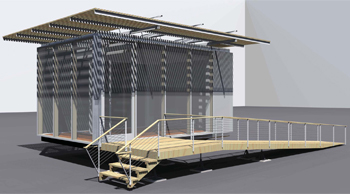
Image Credit: University of Tennessee
Participation in the Department of Energy’s Solar Decathlon is becoming something of a rite of passage for students at many academic institutions that offer programs in architecture, engineering, and interior design.
But in many ways the Decathlon also is a tougher contest now than it was when it debuted in 2002. In January 2008, when it announced the 20 teams selected for the 2009 Solar Decathlon, which is scheduled to take place October 8-18 on the National Mall in Washington, D.C., the DOE mentioned that the number and caliber of applicants had increased significantly. To paraphrase the movie industry’s Oscar nominees, it is an honor just to be chosen for the competition.
One Solar Decathlon 2011 hopeful is the University of Tennessee, whose College of Architecture and Design has assembled a team of faculty, graduate students, and undergraduates that is putting together a proposal – and a building prototype – for what would be its first Solar Decathlon. The UT project includes a summer-session construction course at the college in which a student-designed module for the team’s UT Zero Energy House is being fashioned into a functional prototype. The course ends August 6.
A mountain of details
The essential criterion for each Decathlon entry is that it is powered exclusively by the sun, but there are, of course, scores of other issues that the UT team must address before it submits its proposal to the Department of Energy. Decathlon judges, for example, score each project on its performance in 10 areas – architecture, market viability, engineering, lighting design, communications, comfort zone (temperature and humidity), hot water, appliances, home entertainment, and net metering – so each applicant has to be attentive to each in developing its proposal.
Teams selected to compete are given $100,000 by the DOE to get started, but they also are responsible for whatever fundraising will be needed to complete their project and transport it (and team members) to and from Washington. It is, in other words, a full-fledged design-and-construction enterprise, with the appearance on the National Mall the capper to more than three years of intense work.
The UT team has been focused on strategies for keeping material and construction costs as low as possible while still meeting high energy-efficiency standards. Eventually, says UT grad student Neil Parrish, the team would like to see the house go into mainstream production. But that, along with landing a spot in the Decathlon, is requiring extraordinary diligence.
“We are finding out it’s a little tough,” Parrish told local TV station WATE Channel 6. “You need lots of insulation, really high-value materials, and good craftsmanship.”
Weekly Newsletter
Get building science and energy efficiency advice, plus special offers, in your inbox.














One Comment
Teams selected to compete are
Teams selected to compete are given $100,000 by the DOE to get started which is the good price to start.
Log in or create an account to post a comment.
Sign up Log in